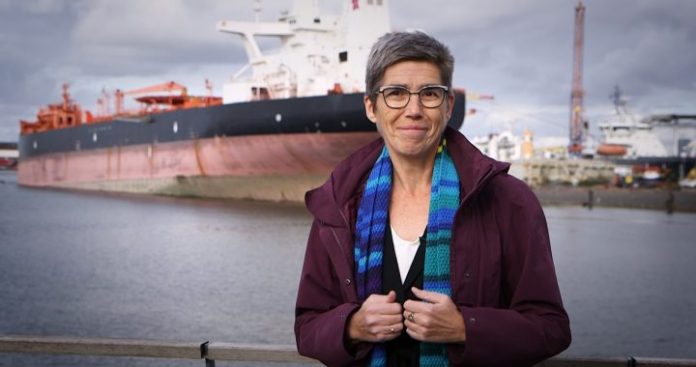 The Marine Environment Protection Committee (MEPC) meets next week to debate the latest provisions for the decarbonisation of shipping, MEP Jutta Paulus explains why the European Parliament backed the proposals to include shipping in the EU’s Emissions Trading System.
The Marine Environment Protection Committee (MEPC) meets next week to debate the latest provisions for the decarbonisation of shipping, MEP Jutta Paulus explains why the European Parliament backed the proposals to include shipping in the EU’s Emissions Trading System.
In September, the European Parliament adopted its position for a revision of the Regulation on the monitoring, reporting and verification of carbon dioxide emissions from maritime transport ((EU) 2015/757) by large majority, also simply known as the “MRV Shipping Regulation”.
What started as a formal adjustment to align EU and IMO measures on emission counting and reporting became the most ambitious approach to decarbonise international shipping. Our demands will significantly pave the way for more climate ambition and will help [the EU] to reach climate neutrality.
The maritime transport sector emitted globally around 1,076 million tonnes of CO2 equivalent in 2018, which correlates to about 2.9 % of global greenhouse gas emissions. Between 2012 and 2018 alone, greenhouse gas emissions from maritime transport increased by 9.6%, including a sharp increase of methane emissions due to the surge of ships using liquefied natural gas.
International maritime transport generates more greenhouse gas emissions than any single EU Member State. If the shipping sector were a country, it would be the country with the sixth highest greenhouse gas emissions worldwide. Nevertheless, it is the only transport sector not regulated by concrete emission reduction goals.
The European Parliament declared a climate emergency in November 2019. This implies a responsibility to initiate and implement measures to achieve the Paris climate agreement targets as quickly and comprehensively as possible. According to the latest IPCC report, there is only a 66% chance of staying below 1.5 degrees Celsius if future greenhouse gas emissions are limited to 420giga-tonnes (Gt) of CO2 equivalent or 10 years of current emissions. And, there is only a 50% chance of staying below 1.5 degrees Celsius if future emissions are limited to 580Gt CO2e or 14 years of current emissions.
The shipping sector must therefore play its part in environmental and climate protection. With regard to the European Green Deal, the amending of the MRV Shipping Regulation is a crucial test for the EU’s sincerity and commitment with regard to climate action.
For me as the European Parliament’s rapporteur it was clear from the beginning: Counting emissions does not reduce a single gram of them. Nevertheless, the importance of broad and detailed data cannot be underestimated. The existing MRV Shipping Regulation has provided us with a precious insight into the amounts of emissions emitted by ships operating in the EU’s Economic Area. This valuable and evidence-based tool is the foundation for the further steps we aim to take.
To put it in a nutshell, the European Parliament’s two main goals are to reduce greenhouse gases from shipping and to minimise the administrative burden for businesses and administrations. To achieve this goal, we aim to include maritime emissions into the EU’s Emission Trading Scheme ETS by 2022. European Commission President Ursula von der Leyen and Vice President Frans Timmermans also called for this when announcing the European Green Deal and the EU’s climate targets for 2030. The European Commission will conduct an impact assessment to evaluate the consequences for the economy and for climate targets.
As Europe’s goals for 2030 will be raised to 55 – 60% emission reduction compared to 1990, including – for the first time – emissions from shipping and aviation, action in these sectors is inevitable. And although European shipowners were worried whether they might suffer an economic disadvantage, the approach taken in the MRV creates a playing field as level as the sea surface in a doldrum: All ships calling at ports of the European Economic Area are within the scope of the MRV Shipping Regulation.
However, the sector is not left alone: The European Parliament proposes to use 50% of the maritime ETS revenues to establish an Ocean Fund. This fund will finance research and development and support investments in the decarbonisation of the sector, e.g. by improvement of the energy efficiency of ships. Some 20% of the Ocean Fund will contribute to the protection, restoration and better management of marine ecosystems impacted by global warming. The remaining half of the maritime ETS revenues shall be used to tackle climate change in the European Union and in Member States.
To truly lower emissions, the European Parliament further demands to set an efficiency target of 40% by 2030. This target shall be based on data from the MRV-THETIS, as well as from the IMO DCS. That would oblige shipping companies to linearly reduce the annual CO2 emissions per transport work by at least 40% until 2030. This target stands for an average across all ships under a company’s responsibility and compares to the average performance per category of ships of the same size and type. By implementing this emission reduction target, the European Union would save 1.5% emissions. This amount again translates to 10% of the emissions gap of the newly formulated EU climate target.
Compared to the IMO reporting scheme, the MRV Shipping Regulation offers advantages that valorise the collected data. Especially the parameter “cargo carried” is of utmost importance, as it allows for clear comparisons with regard to the actual load. In contrast to IMO’s DCS, which calls for the flag states to report emissions, the obligation of reporting the data, meeting the efficiency targets and paying for ETS certificates is attributed to the shipping companies. As the ship operator decides on load, speed and route, it would be illogical to hold the ship owner responsible for the resulting emissions.
The current MRV Shipping Regulation only applies to CO2 emissions, even though methane emissions have an 87 times higher greenhouse gas effect over a timeframe of 20 years. Because of its dangerous climate impact, the European Commission has issued a new EU Methane Strategy, which will be accompanied by concrete measures to tackle methane emissions from a variety of sectors. With regard to emissions from maritime transport, the European Parliament called to include methane into the new MRV Shipping Regulation already.
Emissions caused by shipping are not only harmful to the global climate, but also cause pollution. Especially with regard to health impacts for citizens of port cities, the European Parliament is calling for “zero emission ports”. Particulate matter and nitrogen oxide are responsible for more than 400,000 premature deaths in the EU, and while cars have become cleaner due to EU standards, considerably lowering urban pollution, shipping is still steaming below the radar of emission regulation. Only sulphur oxides have had limit values set – after a decade’s long discussion.
The existential threat posed by climate change requires immediate action and the will for change is there. In particular the European Parliament is stepping up its pursuit of far-reaching and urgently needed measures. Besides the new MRV Shipping Regulation, legislators also voted for an ambitious climate law raising the EU’s emissions reduction target to not only 55%, as suggested by the European Commission, but to 60%. Moreover, Parliament calls for initiatives for clean maritime transport. With the Commission also aiming for binding measures in the shipping sector, we are now looking forward to negotiations with the Council. An ambitious and binding MRV Shipping Regulation will be one step further for the European Union’s global leadership in climate action.
 Jutta Paulus has been a Member of the European Parliament for the Greens since 2019. She is a member of the committees on Environment, Public Health and Food Safety (ENVI), Industry, Research and Energy (ITRE) and Transport (TRAN).
Jutta Paulus has been a Member of the European Parliament for the Greens since 2019. She is a member of the committees on Environment, Public Health and Food Safety (ENVI), Industry, Research and Energy (ITRE) and Transport (TRAN).
Paulus started her career as a pharmacist, co-founded an independent laboratory for the examination of chemical hazards, and worked in quality management. From 2017 to 2019, she was the regional co-president of the Rhineland-Palatinate Greens.
In dedicating her political work to climate, energy and environmental challenges, she aims to achieve effective EU-wide action against climate change and that human beings, animals and nature are protected from destruction, pollution and poisoning.







